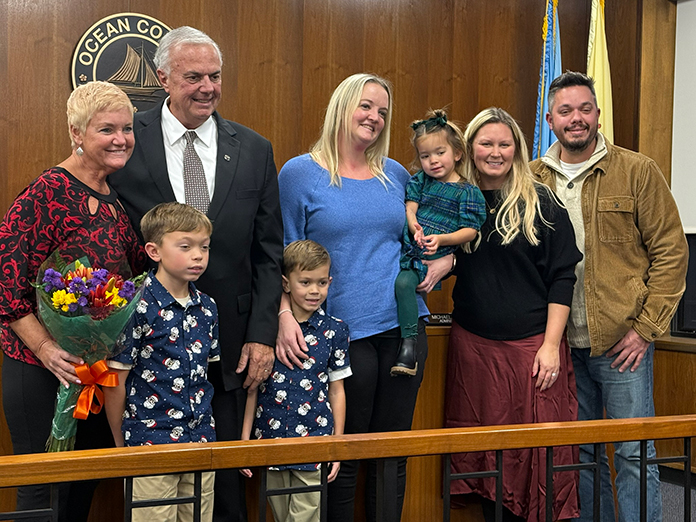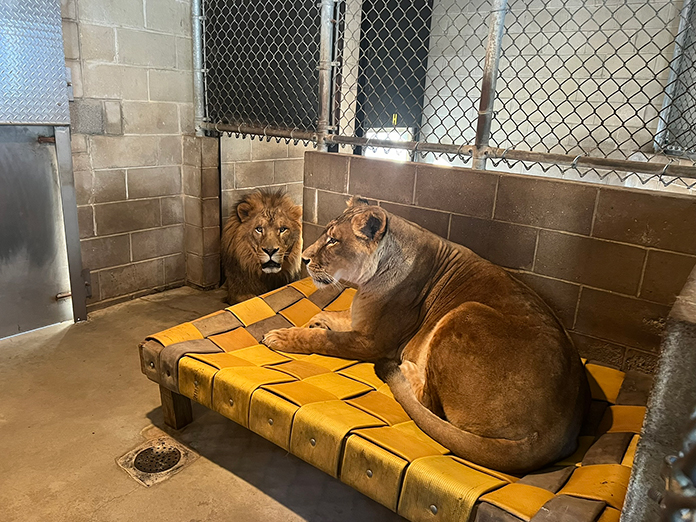BRICK – Eva Maravelias and her husband Brian Wenckebach walked into the conference room at Hackensack Meridian Ocean University Medical Center (OUMC) in Brick, overcome with emotion. Nearly a year ago, Eva had been wheeled into the hospital, barely clinging to life after a rare and catastrophic heart condition tore through her arteries. The 45-year-old mother of two returned to the hospital to thank the “first angels” who stabilized her during the most harrowing moment of her life.
The reunion brought together the OUMC’s Cardiac Catheterization Lab team, the air medical flight crew, and a cardiac rehabilitation nurse who helped her recover from spontaneous coronary artery dissection (SCAD), a rare and potentially fatal heart condition.
“I couldn’t open my eyes and couldn’t speak to you guys,” Eva recalled, tears welling up. “But in my mind, I was praying. I could hear your voices, and I knew God was with me. You were all part of my journey.”
Eva Maravelias describes what she was feeling on that fateful day. (Photo by Stephanie Faughnan)
The reunion was emotional for everyone involved. Eva exchanged hugs, starting with Dr. Arthur Okere, the interventional cardiologist who led her care, the nurses who stayed by her side and the flight team that ultimately transported her to Hackensack University Medical Center’s main campus in Hackensack. She also shared stories of joy with the cardiac rehab nurse she worked with at Jackson Health Village.
“We don’t often get to see the end of the story,” the head nurse from the Cath lab admitted. “We stabilize patients, transfer them, and rarely know what happens next. Seeing you here, healthy and smiling, means everything.”
A Sudden Crisis
Two weeks before her life-threatening medical event in March of 2024, Eva Maravelias experienced a strange feeling she couldn’t quite explain. It wasn’t painful, but it lingered. Busy with work and grieving the recent loss of her mother-in-law, the Toms River mother of two brushed it off.
“I just ignored it,” Eva admitted. “I had so much going on. I didn’t think much of it between work stress and everything at home.”
On the day of her cardiac emergency, Eva’s schedule was as hectic as ever. She had recently returned from Beverly Hills, where she had spent a week opening a new store for her job at Saks Fifth Avenue. The workload and personal challenges weighed heavily on her.
“I think the stress kind of took over,” she said. “That morning, I was working from home. I had just finished a conference call with a colleague when I started feeling really strange. I was completely exhausted as if I just needed to sleep. My voice was trailing off as I spoke, and I didn’t realize it, but I was about to pass out.”
“I was lucky enough to at least call up to my husband before I passed out,” Eva said. “I said, ‘Brian,’ and he heard me.”
Brian ran downstairs to find Eva collapsed on the floor on the lower level of their home. She wasn’t in pain but seemed more tired than anything else.
Neither Eva nor Brian could have expected anything to be seriously wrong with her. She was on no medications and was in great health. Eva had only been hospitalized for the birth of their two children.
Eva was rushed to Ocean University Medical Center, where an electrocardiogram initially suggested a heart attack. But when Dr. Okere and his team examined her heart in the cardiac catheterization lab, they uncovered a far more severe issue: spontaneous coronary artery dissection (SCAD).
“All her arteries were torn,” Dr. Okere explained. “This wasn’t just a typical SCAD; it was an extreme case. Her heart was barely functioning. Without immediate intervention, she wouldn’t have survived.”
Dr. Arthur Okere points to the monitor in OUMC’s Cardiac Catheterization Lab to provide details about Eva’s condition. (Photo by Stephanie Faughnan)
The Fight To Save Her
In a mock, albeit very real, setting at OUMC’s Cardiac Catheterization Lab, Dr. Okere provided the details of Eva’s condition. He essentially invoked his inner detective to determine the cause, pointing out aspects of the heart and arteries on the monitor used in the lab.
Eva was on a ventilator and had already suffered cardiac arrest when Dr. Okere first saw her in the emergency room. As part of his evaluation, Dr. Okere looked at the coronary arteries, expecting to see a blockage.
“As it turns out, all of the coronary arteries were torn to shreds,” said Dr Okere. “Spontaneous coronary artery dissection happens most in young females in moments of high stress – emotional or physical stress.”
Dr. Okere said that he’d come across SCAD a few times in his career in cases after a woman had just given birth. Most typically, there had been only one vessel involved. Eva’s case was anything but typical – every vessel was torn.
“She just had so many vessels torn, and so many vessels dissected that the damage to her heart was so severe she was definitely going to die if we didn’t intervene,” Dr. Okere explained.
Immediate intervention required inserting an Impella device, a small heart pump designed to support the heart’s function. Dr. Okere explained that the device is a catheter inserted through an artery in the groin and guided up to the heart.
“The catheter is placed within the heart chamber, where it pulls blood from inside the heart and pumps it out to the rest of the body,” Dr. Okere said. “Essentially, it takes over the workload of the heart.”
Eva Maravelias and her husband, Brian Wenckebach, stand with the team that helped save her life. (Photo by Stephanie Faughnan)
The catheter is connected to a motor, which powers the mechanism, ensuring blood circulation continues while the heart recovers. However, the extent of Eva’s tears was overwhelming.
Once stabilized, Eva was airlifted to Hackensack University Medical Center for additional care. Dr. Mark Anderson, chief of cardiac surgery, inserted a larger Impella device to assist with blood flow. After several days, Eva’s condition improved, and she was discharged to begin rehabilitation.
Eva wasn’t present when Dr. Okere explained the details of how her life was saved. However, she did remember hearing those around her as they spoke as they intervened.
“I could hear the nurses saying, ‘She’s so young,’” she recalled. “I wanted to tell them, ‘I’m still here. Don’t give up on me.’”
The post Local Mom Thanks Lifesaving Team After Rare Heart Crisis appeared first on Jersey Shore Online.





